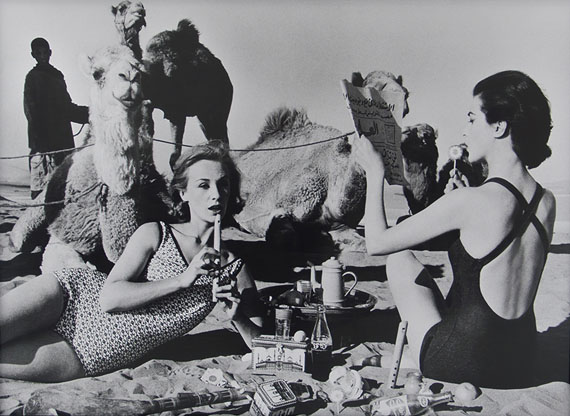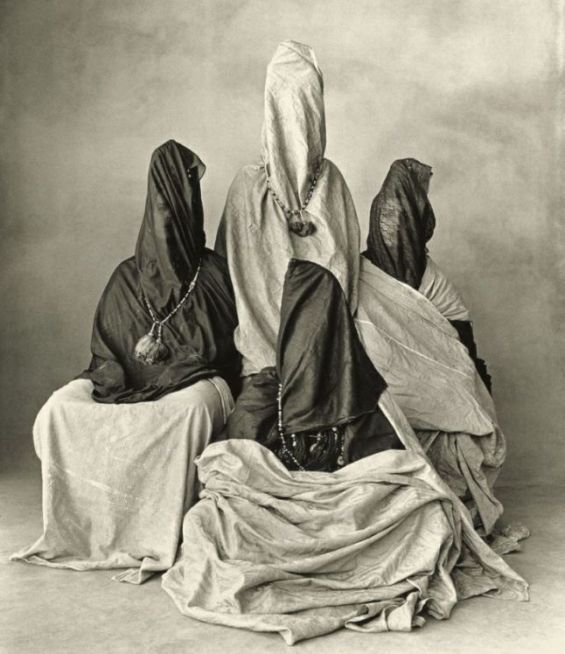Visited by celebrities, artists and talented people from all over the world, Morocco was also a preferable destination for a number of distinguished photographers. Today, Yabiladi is shedding light on three of these artists who took from their time, packed their lenses, lights and cameras to shot iconic and authentic scenes in the North African Kingdom.
And as most of the shootings that took place in Morocco had to do with fashion, culture, and ethnography, it is a must to start with the magnificent Irving Penn. The American photographer who worked for Vogue Magazine and who is mostly known for his photographing covers, portraits, still lifes, fashion, and photographic essays, has indeed been to Morocco.
The blue people in Guelmim
His visit took place in the beginning of the 70s and was part of his travel for Vogue. In fact, between 1964 and 1971, Penn flew to «Japan, Crete, Spain, Dahomey, Nepal, Cameroon, New Guinea, and Morocco» and «on these trips he was increasingly free to focus on what truly interested him : making portraits of people in natural light», says his biography. And that is exactly what happened in Morocco. Alongside his wife, Penn arrived in the Kingdom he described as «a mysterious world of Casbahs, oases, horsemen, and painted women».

In their book «Irving Penn : Centennial» (2017), Adam Kirsch, Jeff Rosenheim, and Maria Morris Hambourg brought up the details of this trip. With his spouse, cameras and crew, Penn arrived in Guelmim, determined to photograph Tuareg camel nomads or the «blue people», a nickname they gained because of their indio-blue or black linen clothes that stain their skin. However, and as pointed out in the above-mentioned book, «Penn found that these migratory tribesmen, marvelously turbaned and veiled with the Taqulmust, refused to be photographed».
The tribesmen did not trust Penn and refused to pose in front of his lenses for a reason that he seemed to neglect. «Always distrustful of government officials, they (tribesmen) likely avoided Penn in part because he and his crew were transported in a minibus marked as belonging to the Moroccan ministry of information», wrote the book.
However, the photograph managed to make these proud nomads stand in front of his camera. According to the same account, he gathered «dancers, children, old men and a troupe of blue women to sit for his camera» and the result was marvelous. His photos were featured in Vogue, showing the Guedra women, a traditional trance dance performed by the blue women, dancers a bride and a child wrapped up in cloak.
In the description that came with the photos, Penn wrote «the day seems not far off when men and women will be blended into an undifferentiated mass dressed western styles».
Penn’s trip to Guelmim and his photos were documented in a making of video available on the internet. In a rare footage put together by the Metropolitan Museum, Penn installs his portable studio and takes pictures of Moroccan men and women. The video is shot by Lisa Fonssagrives Penn in 1971 when her husband visited Morocco.
A forgotten trip
From Penn’s famous trip to a more discreet one made by British photographer Peter Fordham. Known for taking the photo of John Lennon’s second solo album «Imagine», the man happened to tour the country in the 70s, taking photos of his trip.
However, and as strange as it might sound, Fordham’s visit was discovered recently just out of the sudden. While visiting an antique market in London called the Junk Shop, Stephen Dowling, a New Zealander photographer, found the photos tracing Fordham’s trip to the Kingdom.

«There, in a box next to an old dresser, I found a stack of old Kodak slide boxes, filled with old Kodachrome slides. On the side of several was Fordham’s name. And inside was a time capsule of the 1970s – not of London, but of Morocco», wrote Dowling in a Peta Pixel article.
According to him, Fordham’s photos were not intended to be part of an editorial shoot; they were just a way of reporting his journey and the places he visited. And as he pointed out, «the photos are not staged shots for adverts or an editorial shoot – these are pictures taken by a tourist who just happens to be an excellent photographer».
In his pictures, Fordham pictured landmarks, random people, pedestrians, roads, the car he was driving and even himself posing by the side road after a trip to the city of El Jadida.
A picnic in the Kingdom
Way before Penn and Fordham decided to fly to Morocco, American fashion photographer William Klein made beautiful models picnic there on the beach next to camels. His visit was marked by a series of photos where two models wearing swimming suits, were lounging on the sand. One was playing the flute while the other was reading the Arabic-language newspaper, Al alam. The photos scream Morocco in both their black and white and colorful versions as you can see a Moroccan teapot on the ground, two camels and a young boy curiously watching the two ladies sunbathing.

These three photographers's works of art were later made public, showcasing the Morocco they liked the most and which included the sun, the tribal vibes and the landscape.





 chargement...
chargement...













